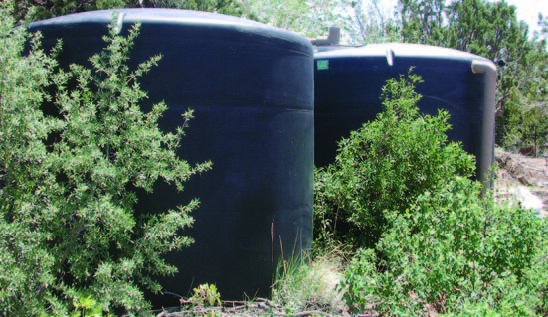The PermaDesign Weblog, with Nate Downey and Melissa McDonald!
Roof-Reliant Landscaping™ Step 13C: Cost Estimating PHASE 3: Estimating Your Cistern System
Although it is helpful to be familiar with every feature of your cistern system during the costestimating process, this knowledge is not required to arrive at an accurate estimate. Obvious costs include the tank(s), delivery system, pump, pipe connections, excavation and backfilling. Less obvious cistern system expenditures include a pumphouse, a sediment trap, a vent, overflow piping (and associated erosion control structure[s]), a pressure tank, a level reader, at least two 110-volt (minimum) electrical circuits, a float switch and the cost of removing (or using) excess dirt from the excavation process.

Cistern tank delivery can be a sizable installation cost. Most tanks are not put together on-site. Consequently, the cost of shipping a tank that ranges in size from a small car to an 18-wheeler truck is given a separate line item on Worksheet 3. Delivery may also include renting a crane large enough to lift a steel tank over your house.
Especially for underground and partially buried cisterns, excavation can be costly. Aboveground tanks typically do not require a line item for excavating around the tank, but some excavation is often necessary for at least some piping and the pumphouse. When excavation costs are low, you should expect to spend a little more money on landscape features that lessen the tank’s visual impact, and additional costs could involve securing aboveground tanks (when empty) from high winds or pouring a concrete slab under an aboveground pumphouse. In addition, don’t forget the costs of backfilling (and proper tamping) dirt back on top of all of the subsurface work.
Pipe connections include roof gutters, downspouts, drains, conveyance piping, first-flush devices, vent piping, electrical conduit, pumprelated piping and pipes that connect cisterns together. These are described in greater detail in Chapter 8, but it is important here to recognize the materials and labor costs involved in this complicated matrix.
Sediment traps and first-flush devices are relatively inexpensive items that act as filtration mechanisms for all of your roof water. For ease of maintenance, these are usually conveniently located in your system’s conveyance piping (which directs water from your roof to your tanks). This is a highly recommended item because it prevents significant future expense when too much solid matter collects at the bottom of your cistern. The water pump and associated parts and labor certainly need a line item on your spreadsheet. Submersible pumps, which are installed at or near the bottom of the cistern, propel water out of the cistern, while in-line pumps, which are typically installed in a separate pumphouse, draw water out of the cistern via a pipe through the pump and run toward the distribution system. Note that an in-line pumphouse system, although it has some advantages, usually requires a greater initial investment.
Every cistern needs a vent so that air can enter the tank when water is pumped out. (Underground tanks typically have a vent pipe that protrudes from the ground.) Vents are also important during flood events because they provide space for air to escape, and this allows your overflow pipe to work more effectively. The cost of venting a cistern is often very low, but this does not mean venting is less important than other items. Remember also to consider the cost of creating a view screen for your vent if needed.
Overflow piping is essential for times when the cistern is full and precipitation is occurring. On relatively flat, level sites, this can become a significant cost because overflow pipes need to reach a daylight point in order to be effective. A daylight point is the place at which overflow water can become surface runoff. The cost of this piping is usually very little, but the cost of controlling erosion from the large flows of water that periodically pass through such pipes should not be underestimated.
(NOTE: Make sure that the ends of all vent pipes and overflow pipes have a screen covering of small enough mesh to keep mosquitoes from entering.)
Many systems have a number of accessories including pressure tanks, level readers, float switches, heating mechanisms and others that will be discussed in greater detail in Chapter 9, Water Storage. Keep in mind that the cost of getting professionals—such as licensed electricians, plumbers, irrigators and cistern systems installers— involved early in your design project is almost always worth the effort. For example, your pump will need electrical power, and many of the accessories often require dedicated low-volt, 110-volt or 220-volt circuits. Be sure to outline the work order for each professional up front in order to prevent costly change orders.
One potentially significant cost is that of dirt removal. For now, suffice it to say that not only are there often expenses associated with a pile of dirt the size of a school bus, serious fines can be levied on those who dump dirt illegally. In a bestcase scenario, your extra dirt will become a resource (for use in terraced beds, for example). But in other cases, you might have to pay a surprisingly high price for the removal of the dirt leftover from an underground cistern installation.
In the simplest cistern system, water distribution components may consist of only a valve, a garden hose and a spray nozzle. However, many distribution systems include an automated drip irrigation system connected to a pump and a pressure tank. The associated parts for water distribution range from expensive computerized valve controllers to plastic emitters and couplings that cost pennies apiece.
11/06/2015 | (0) Comments










Comments